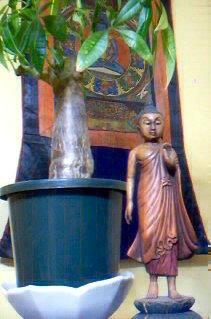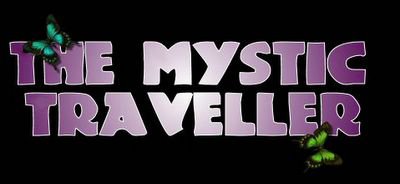Monkey Bones & A Charming Buddha

My Naga Monkey Skull Charm
When I was in Myanmar last summer, I revisited a merchant’s store in Mandalay. The store specializes in unique crafts and arts that are found throughout the region. It is a rather strange place, with thousands upon thousands of tempting objects stacked upon shelves, dangling from the ceilings and locked away in display cases.
Among the many beautiful wooden, jade and bronze Buddha figures, are also the very devilish-like creations of the Naga people. The Naga people are indigenous to the land that falls on the Indian-Myanmar border. In Assam, there has been a violent struggle for independence, which has made the region particularly volatile and out-of-bounds to travellers.
The Naga used to be ferocious headhunters. As Animists, they have a long tradition of creating unusual totems and necklaces made from animal bones. When I first visited Mandalay, I was particularly attracted to several examples of Naga crafts that were on display at the store. Hanging from the rafters, were several monkey skull necklaces. Being somewhat of a fiend for occultic objects, I was immediately attracted.
Whilst some of the skulls had browned with age, and had even lost some teeth, there was one with an eerie look in his eye; a spider had built a nest within the eye socket, which gave the skull the impression that it was staring. The chord that it was hung-on had long hollowed out bones, with strange magical protection symbols carved into them. The skull was further enhanced with the addition of two long black horns.
I could not resist, and so after some haggling, I agreed on paying $25 for it – a bargain for something so curious. The necklace certainly stimulates conversation when people see it on the wall that it is hung.
At first, I felt a little uncomfortable with him staring down at me, and thought of W. W. Jacobs classic spook tale, The Monkey’s Paw. But, after time, and asking politely for his blessings, I have concluded that a little Naga magic is not necessarily a bad thing to have protecting you!
When I returned to the store on my second Myanmar trip, I was once again attracted to every item on show. If I had a large enough place, and more importantly, a wallet full of money, I would have bought the entire shop. That was, of course, not to be, so I carefully perused items in the hope of discovering the perfect purchase.
As my eyes flitted across the many statuettes, a beautifully painted wooden Buddha, locked inside a glass cabinet, caught my attention. I asked the shop assistant how much it was, and he told me that it cost $50. As is the way with haggling, I immediately started the mind games. Instead of responding to his answer, I continued to walk around, only sporadically returning to the Buddha figure, to reassert silently my interest in it.
After some time, quietly strolling about, I then pretended that I was about to leave. The shop assistant chased after me, and asked me how much I would pay for the Buddha. I replied that I had no idea, and asked him for a lower price. He now dropped it to $40. In response, I said that I would pay $20. He scoffed, as was expected, but again lowered the price to $35. Again, I pretended to act as if I was leaving. He then told me that I could have it for $30, at which point, I said that I would think about. I left the store, and headed to a teashop further down the street.
After half an hour, I returned with my trishaw driver, and asked the man for a final price. He rolled his eyes and then offered it for $25, which I happily agreed to.

My Charming Buddha
Haggling is always an alien practice for me, even though it is a widely used custom in many countries throughout the world. I have always held the view that a traveller should consider not only the value of the item that they may be interested in, but also the circumstances of the seller. Some people visit developing countries and will fiercely fight over literally pennies – pennies that can make a huge difference to someone locally. It has to be about balance and fairness.
After returning back to Japan, I unwrapped my newly acquired Buddha, who would be treasured like the others in my collection. He now stands rather handsomely upon my television. Unfortunately, though, because of the dryness of the air in my apartment, compared to the constant humidity of Myanmar, the wood that the Buddha is made of, has started to split apart from his face down to the lotus beneath his feet, and it looks as if he will break entirely apart at some point! However, he will remain loved and appreciated, whatever state he may end-up.
Among the many beautiful wooden, jade and bronze Buddha figures, are also the very devilish-like creations of the Naga people. The Naga people are indigenous to the land that falls on the Indian-Myanmar border. In Assam, there has been a violent struggle for independence, which has made the region particularly volatile and out-of-bounds to travellers.
The Naga used to be ferocious headhunters. As Animists, they have a long tradition of creating unusual totems and necklaces made from animal bones. When I first visited Mandalay, I was particularly attracted to several examples of Naga crafts that were on display at the store. Hanging from the rafters, were several monkey skull necklaces. Being somewhat of a fiend for occultic objects, I was immediately attracted.
Whilst some of the skulls had browned with age, and had even lost some teeth, there was one with an eerie look in his eye; a spider had built a nest within the eye socket, which gave the skull the impression that it was staring. The chord that it was hung-on had long hollowed out bones, with strange magical protection symbols carved into them. The skull was further enhanced with the addition of two long black horns.
I could not resist, and so after some haggling, I agreed on paying $25 for it – a bargain for something so curious. The necklace certainly stimulates conversation when people see it on the wall that it is hung.
At first, I felt a little uncomfortable with him staring down at me, and thought of W. W. Jacobs classic spook tale, The Monkey’s Paw. But, after time, and asking politely for his blessings, I have concluded that a little Naga magic is not necessarily a bad thing to have protecting you!
When I returned to the store on my second Myanmar trip, I was once again attracted to every item on show. If I had a large enough place, and more importantly, a wallet full of money, I would have bought the entire shop. That was, of course, not to be, so I carefully perused items in the hope of discovering the perfect purchase.
As my eyes flitted across the many statuettes, a beautifully painted wooden Buddha, locked inside a glass cabinet, caught my attention. I asked the shop assistant how much it was, and he told me that it cost $50. As is the way with haggling, I immediately started the mind games. Instead of responding to his answer, I continued to walk around, only sporadically returning to the Buddha figure, to reassert silently my interest in it.
After some time, quietly strolling about, I then pretended that I was about to leave. The shop assistant chased after me, and asked me how much I would pay for the Buddha. I replied that I had no idea, and asked him for a lower price. He now dropped it to $40. In response, I said that I would pay $20. He scoffed, as was expected, but again lowered the price to $35. Again, I pretended to act as if I was leaving. He then told me that I could have it for $30, at which point, I said that I would think about. I left the store, and headed to a teashop further down the street.
After half an hour, I returned with my trishaw driver, and asked the man for a final price. He rolled his eyes and then offered it for $25, which I happily agreed to.

My Charming Buddha
Haggling is always an alien practice for me, even though it is a widely used custom in many countries throughout the world. I have always held the view that a traveller should consider not only the value of the item that they may be interested in, but also the circumstances of the seller. Some people visit developing countries and will fiercely fight over literally pennies – pennies that can make a huge difference to someone locally. It has to be about balance and fairness.
After returning back to Japan, I unwrapped my newly acquired Buddha, who would be treasured like the others in my collection. He now stands rather handsomely upon my television. Unfortunately, though, because of the dryness of the air in my apartment, compared to the constant humidity of Myanmar, the wood that the Buddha is made of, has started to split apart from his face down to the lotus beneath his feet, and it looks as if he will break entirely apart at some point! However, he will remain loved and appreciated, whatever state he may end-up.



1 comment:
I have to agree with you about haggling, I hate to do it. I even go to no-haggle car lots specificly to avoid it. I guess when I start to travel more I will have to get used to it though.
I also agree with splitting hairs on pennies. I'll agree if we are looking at $10 or $20 dollars, but I would guess most western travellers can afford to "over spend" by a buck or two and that could make such a huge difference in someone's life.
Post a Comment